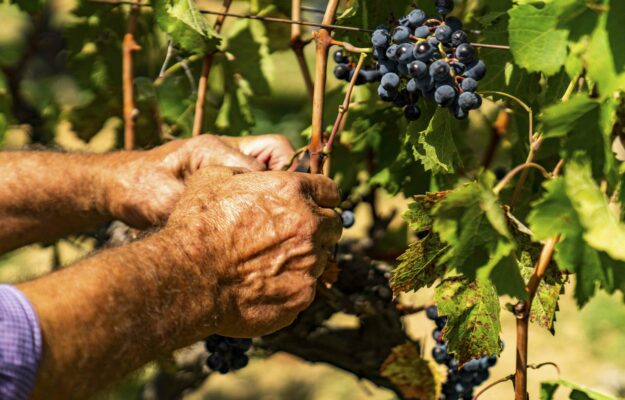The long drought in winter, the abundant rain in spring, the downy mildew, the great heat: there are many, as is now well known, elements that have thrown great uncertainty on the 2023 grape harvest, which kicked off in recent days, in Sicily. An uncertainty that is also reflected in the various production estimates hazarded so far. If the many consortia of Italy’s most important appellations, heard in recent days by WineNews, quantify the expected reduction of grapes between an optimistic -5% in some areas of Tuscany, such as Montalcino, and a -35% declared by Sicily, passing, for example, between a -10/-20% of Valpolicella, a -10/-15% for Chianti and Chianti Classico, a -20% of Bolgheri, -20/-25% in Marche and -30% in Abruzzo, and with very few exceptions that will see, instead, a higher harvest than in 2022, Coldiretti has spoken of a -14% at the national average level, while the Assoenologi, Ismea, and Unione Italiana Vini (Uiv) Harvest Observatory, which will release its more complete estimates on September 12 in Rome, has estimated a harvest reduction of between 25% and even 60%, in some regions, and great suffering for the organic vineyard (which accounts for 20% of Italian rows), which would be largely compromised in several areas of Italy. Estimates, the latter, in line with those issued today by Confagricoltura, the largest organization of Italian agricultural enterprises, according to which “after years of early harvests, 2023 restores the balance of harvest times, in some cases even late, but leaves its mark on the quantity, in almost all of Italy decreasing by 20 to 50%”. A picture, this one, that crosses with harvest forecasts in France by the transalpine Ministry of Agriculture, through Agreste, which speaks of a -3%, for production around 44.5 million hectoliters for French wines, and those of the cooperatives of Spain, which speak of a -12% compared to 2022, mainly due to temperatures for long periods above 40 degrees, reports “Vitisphere”, for just over 36 million hectoliters estimated production in 2023, would redraw, for what it’s worth, the podium of the world’s largest wine producers, with France returning first, ahead of Italy and Spain.
But net of this, returning with Confagricoltura’s eyes to the vineyard in Italy, “the climatic trend has deeply affected grape ripening and the volumes produced, both because of spring frosts and heavy summer hailstorms mainly in the North, and because of downy mildew which has reappeared with virulence, especially in the Central South, due to persistent humidity”, as emerged at the latest meeting of Confagricoltura’s National Wine Federation, attended by the presidents of the regional sections to summarize the situation before the start of the harvest.
The reduction, Confagricoltura explains, is evident in many regions: parts of Piedmont, Friuli Venezia Giulia, parts of Liguria, Tuscany, Emilia Romagna, Umbria, Marche, Abruzzo, Campania, Molise, Basilicata, Calabria, Puglia and Sicily. Bucking the trend are Lombardy, Trentino Alto Adige and Veneto, where today quantities are estimated to be 5% higher than in 2022.
“In such a complex context”, says Federazione Vino Confagricoltura president Federico Castellucci, “Italian winemakers have done everything they could, but they have been put to the test to combat plant diseases exacerbated by the bizarre weather. For those who do organic viticulture, in some areas, even a more than halved grape harvest in terms of quantity is expected. The next few weeks will be decisive in making the most of production”. Aiding the spread of downy mildew were the heavy rains of late spring and early summer. Italy is not alone in facing this problem: French winemakers are also struggling with the disease, which particularly attacks the most susceptible varieties. “Many processing operations”, Castellucci adds, “could not be carried out because weather conditions prevented access to the land”. The downy mildew emergency is part of the growing and serious problems related to plant diseases in the agricultural sector, for which Confagricoltura is calling for the preparation of an “Extraordinary Plan of Action to Combat the Spread of Plant Diseases”, which will analyze, develop and support specific measures that will lead to strengthening and making more effective the national strategy for monitoring and combating diseases. “Those who were able to treat the vineyards faced additional costs to save the crop. Costs at least doubled, in some cases tripled compared to ordinary vintages, for pest control (fuels, personnel, pesticides), necessarily repeated treatments and diesel fuel, which greatly affect the final profit and loss account and weigh on farm budgets, already reduced due to the drop in consumption resulting from the increase in inflation. And the expected growth in the price of grapes in some areas”, Castellucci adds, “will never be enough to compensate for the increase in costs incurred”. In addition to these problems, there is also the continuous presence of wild boars that do not spare vineyards throughout Italy. And finally, in the run-up to the next harvest, the difficulties in finding labor, which, for the wine sector, accounts for 20% of total hiring in agriculture, persist. The new measures on flows are not smooth in bureaucratic management and, despite the good intentions and the government’s openness to the demands of the agricultural world, they are still stuck on administrative paperwork, which is too slow compared to the times dictated by nature and the needs of companies. With that image of the harvest season as a festive, almost bucolic time, one would say, fading more and more under the brushstrokes of grayness brought by the largely unavoidable, but not only, climatic difficulties.
Copyright © 2000/2025
Contatti: info@winenews.it
Seguici anche su Twitter: @WineNewsIt
Seguici anche su Facebook: @winenewsit
Questo articolo è tratto dall'archivio di WineNews - Tutti i diritti riservati - Copyright © 2000/2025








































































































































































































